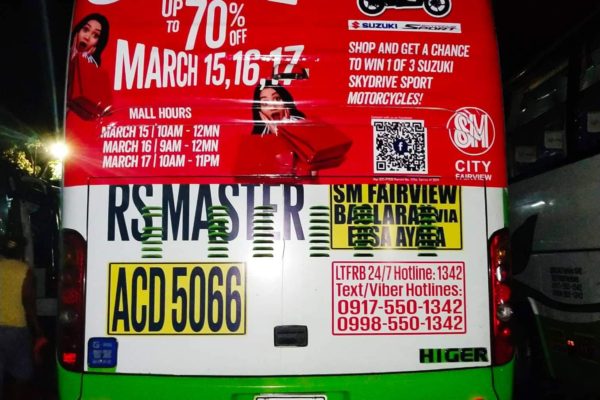Understanding the Function of Transportation Advertising in Enhancing Brand Name Visibility and Customer Engagement
Transit advertising and marketing has actually become a crucial aspect in the advertising landscape, providing unique opportunities for brands to elevate their exposure and involve consumers efficiently. With the capacity to get to a diverse and captive target market during their daily commutes, these marketing approaches are not merely regarding exposure; they have to do with creating meaningful connections with prospective consumers. As we discover the multifaceted benefits and innovative methods within transportation advertising and marketing, it comes to be important to think about exactly how these aspects jointly affect customer assumption and actions, questioning about their long-term influence on brand commitment.
Interpretation of Transportation Marketing
Transit advertising refers to the technique of advertising products, services, or brand names via ads put in and around public transport systems. This kind of marketing includes a range of placements, consisting of posters on trains and buses, digital displays at transportation stations, and covers on the outside of cars. It aims to get to a diverse target market, profiting from the high foot web traffic related to public transportation.
Transit advertising is purposefully positioned to record the focus of commuters, that usually invest considerable time waiting or taking a trip. By incorporating ads into the day-to-day routines of people, brands can create an enduring perception and foster brand name recognition. The tool is especially effective in metropolitan environments, where mass transit is a primary setting of travel.
In addition, transit advertising and marketing can help with localized targeting, allowing businesses to get to particular demographics based upon transit paths and terminal locations. As metropolitan populaces grow and making use of public transport boosts, this advertising and marketing method has actually obtained prominence as a crucial part of integrated advertising strategies. The dynamic nature of transit advertising and marketing, combined with its capability to involve customers in a captive environment, highlights its value in contemporary advertising methods.
Advantages of Transportation Advertising And Marketing
The effectiveness of transit marketing exists in its capacity to supply a multitude of benefits to brands seeking to improve presence and engagement. One of the primary advantages is the substantial reach it supplies; transportation advertisements can effectively target diverse demographics across urban areas, reaching both pedestrians and commuters alike. This broad exposure considerably improves brand understanding.
One more benefit is the high frequency of perceptions. As transit cars follow recognized routes and stop at multiple areas, they develop recurring direct exposure that strengthens brand messages. This frequency fosters familiarity, which is crucial in consumer decision-making.
Transportation marketing is likewise affordable compared to various other media systems. Provided its expansive reach and potential for high impressions, brand names usually experience a reduced expense per thousand impressions (CPM), maximizing their advertising and marketing spending plan.
Additionally, transit ads can develop a sense of community link. By straightening with regional transit systems, brand names can resonate with regional audiences and promote a feeling of neighborhood pride. This localized approach boosts brand name loyalty and involvement, making transit advertising an engaging option for businesses intending to solidify their existence on the market.

Efficient Strategies for Transportation Campaigns
To make best use of the effect of transportation campaigns, brand names should utilize tactical preparation and execution tailored to their target market. First, recognizing the demographic attributes of the audience utilizing public transportation is essential. This permits brands to produce tailored messaging that resonates with prospective consumers.
Next, choosing the appropriate transit mediums is crucial. Whether utilizing bus covers, metro posters, or digital screens, each tool has one-of-a-kind advantages that can improve presence. For circumstances, dynamic visuals on bus covers can bring in attention, while digital ads can be upgraded regularly to reflect timely promotions.
Additionally, incorporating a natural branding strategy across transit platforms makes sure uniformity and reinforces the brand's identity. Utilizing appealing layouts and remarkable taglines will reinforce brand recall among commuters.
Lastly, timing is an essential aspect in carrying out effective transportation projects. Introducing campaigns during top travel hours or regional events can considerably enhance visibility and engagement. By employing these strategies, brands can effectively harness the potential of transportation advertising and marketing, cultivating higher understanding and connection with their target audience. Ultimately, a well-executed transportation project can drive considerable growth in brand name presence and consumer engagement.

Determining Impact and Involvement
In examining the efficiency of transit marketing campaign, accurate dimension of effect and engagement is crucial for brands seeking to enhance their marketing approaches. Metrics such as reach, frequency, and impressions supply foundational information to analyze exposure. Analyzing these aspects helps establish the amount of prospective consumers are subjected to the promotions during their day-to-day commutes.
Interaction can be more evaluated via consumer communications, such as internet site traffic, social media sites discusses, and straight responses to calls-to-action featured in the advertisements. Utilizing tools like QR codes or one-of-a-kind URLs can assist in monitoring of consumer habits straight linked to transit projects. Studies and feedback systems additionally act as important techniques to collect qualitative data on consumer understandings and recall of the promotion.
Moreover, advanced analytics and attribution versions can associate transportation exposure with subsequent getting actions, offering insights into the roi. By using a comprehensive method that integrates qualitative and measurable actions, brand names can create a nuanced understanding of their transportation advertising impact. Ultimately, this data-driven technique allows brands to fine-tune their projects, ensuring they resonate successfully with target market and improve general brand exposure.
Situation Research Studies of Successful Projects
Effective transit ad campaign function as compelling instances of exactly how effective techniques can raise go to this site brand name exposure and interaction. Transit Advertising Philippines. One notable situation is the "I Love New York" campaign, which changed the city's picture and drew in millions of tourists. By utilizing metro advertisements, billboards, and bus wraps, the project produced a strong, cohesive brand name identity, resulting in a substantial uptick in tourist and regional company patronage
Another excellent campaign is Coca-Cola's "Share a Coke" initiative, which leveraged transportation marketing to his response personalize the brand name experience. By featuring popular names on advertising materials across numerous transit systems, Coca-Cola promoted a deeper psychological connection with customers, motivating them to share their experiences on social media sites.
Furthermore, the "Got Milk?" campaign properly used public transportation advertisements to reach a wide audience, strengthening the message of the importance of milk in a well balanced diet. The project saw a measurable rise in milk consumption in target demographics.
These instance studies highlight that when performed attentively, transit marketing can significantly boost brand exposure, foster customer engagement, and drive quantifiable results, demonstrating its essential role in contemporary marketing methods. - Transit Advertising Philippines
Conclusion
In verdict, transportation advertising and marketing offers as an essential device for boosting brand name presence and cultivating customer interaction. Eventually, the capability to determine interaction and evaluate effective instance studies emphasizes the efficiency of transit advertising in driving brand commitment and customer communications.
Transit marketing has arised as a crucial component in the advertising landscape, providing distinct opportunities for brand names to raise their exposure and engage customers successfully.Furthermore, transit advertising and marketing can assist in localized targeting, permitting services to reach specific demographics based on transportation paths and station areas.In assessing the performance of transportation advertising projects, precise blog here measurement of effect and engagement is essential for brand names seeking to maximize their advertising approaches.Effective transit marketing campaigns offer as compelling instances of how efficient strategies can raise brand exposure and engagement.In final thought, transit marketing offers as an important device for enhancing brand name visibility and promoting customer engagement.